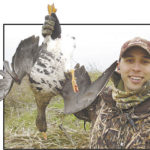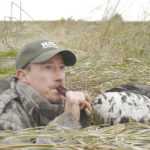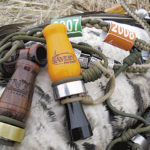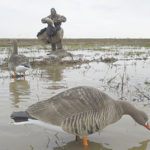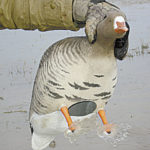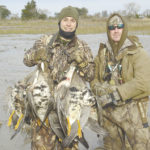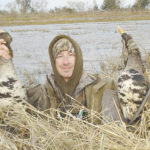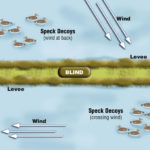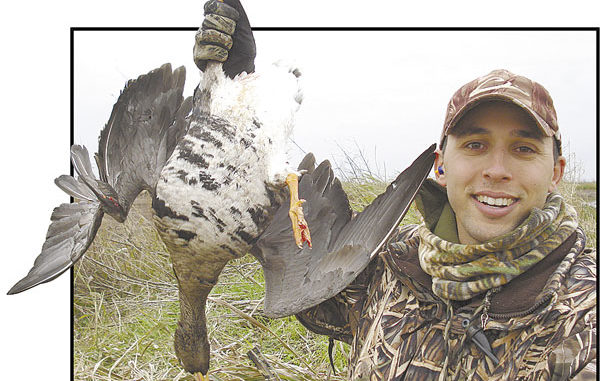
The right tactics ensure that flock of workable geese comes to your field rather than the guy down the road’s.
I got the call, and not a moment too soon. Sure the phone was ringing, but the quacking ringtone denoted the beckon of a hunting buddy to all within earshot of my office desk.
With an early January cold blast projected to bring widespread icy conditions to South Louisiana overnight, the Thursday afternoon invitation could not have been timelier. After all, when word comes of such an uncommon weather event, one almost considered a phenomenon in Louisiana, the next question for any die-hard waterfowler is: Where am I going to hunt the next couple of days?
Gueydan? The Duck Capitol?
I’m in!
As I frantically skimmed my calendar for prior commitments, the outlook was good to join state duck and specklebelly goose calling champion Jason Campbell the next morning in a Southwest Louisiana rice field along with another rice-field regular, Ian Tauzin who is also no stranger to the competition stage.
Best of all, the blind had been well rested and the field was said to be holding strong numbers of specklebelly geese along with ducks seeking to maintain as much open water as possible despite the sub-freezing temperatures.
The next morning couldn’t come soon enough.
As I made my way out of Baton Rouge, the Tigerland bar crowd was just heading home as I passed by on Nicholson. My how my priorities have shifted in recent years. Not so long ago, I was in that crowd, pouring out of the bars after 2 a.m., but things have changed in my post-graduation years as this was a tail-feather pursuit of a far different kind.
On this morning I was a duck-crazed, sleepless, LSU alum, head to toe in full camouflage with ATV in tow, as I headed out of town in the wee hours. A quick glimpse at my LSU ring brought back those days in a flash, but just as quickly my eyes were back to the dash-mounted GPS. The unit was locked in, providing turn-by-turn directions in the dialect of a lovely Australian gal named Karen, right now projecting a 4:45 a.m. arrival in Gueydan.
Though this was a solid 45 minutes prior to the agreed rendezvous time, I figured that just maybe a few winks may be had while parked at the meeting spot. Hey, at least there was zero chance of sleeping through all three alarms I had set as this was no event to gamble on attending.
After an efficient journey to the small town steeped in rice and waterfowl, Aussie-borne Karen put me at the meeting spot in time for a pre-hunt nap, pretty good for a foreigner! Nevertheless, it was not to be. The truck thermometer read 19 degrees with the wind absolutely ripping out of the north following an overnight frontal passage. The wind whipped so hard that the constant clanging of the ATV trailer’s gate precluded any notion of sleep.
But in the few seconds separating the clangs, the cries of early-rising geese could be heard amongst the howling wind. Just as we had hoped, the drastic weather change had the birds up and about particularly early on this frigid morning, in this case, long before sunrise.
As my hunting party made the brief ATV ride out to the blind, the piercing wind chill found every crack between our layered clothing. Fortunately for us, the hunt would be made within the comforts of a pit blind safe from the January gusts whistling overhead.
Though the pond’s north-south orientation allowed it to stay largely open, there was plenty of ice in and around the duck decoys already locked in place. The three of us scrambled to free up the popsicle-beaked duck decoys to make them appear halfway content despite their icy surroundings. The dozen or so full-body speck decoys were carefully placed upwind of the blind to allow for a crossing wind set up.
As the rising sun put a glow on the eastern horizon, it didn’t take long to figure this would be a hunt worth braving the conditions. Ducks of a variety of species could be seen in our immediate proximity looking to join our spread even if the imposters were already beginning to freeze back into place. Though the duck show was very promising, our main pursuit today was getting specklebelly geese in close, and before long the first visitors of the morning were showing from the south. These birds were low and looking, true to the scouting report.
When you’re after specks, it sure doesn’t hurt to share a blind with someone who’s won the Louisiana state calling contest multiple times, and Campbell is certainly not afraid to strike up a welcoming conversation with an approaching flock.
“I prefer to be the lone caller when working a single or pairs of birds,” Campbell said, as he feels it easier to engage lonely birds with a one-on-one dialogue.
However, Campbell notes two callers can be very effective in working a larger group of birds.
“With groups of geese, we’ll often assign a lead caller who will ultimately finish the birds and call the shot, but the second caller can provide key fill-in sounds to mimic a contented flock on the ground,” he said. “As a rule of thumb, big bunches of specks generally respond well to group calling.”
As a Southwest Louisiana native, Campbell has blown his share of speck calls, but as a member of the Rich-N-Tone Calls’ Pro-Staff has come to favor the Arkansas company’s offerings of goose calls, which seemed to best fit his style of calling. Campbell feels that the mylar reeds combined with a narrow bore allow for high volume and versatility on both the calling stage and in the blind.
Nevertheless, Campbell rarely hits the field without two speck calls dangling on the lanyard.
“I’ll usually tune one to be higher-pitched offering a clearer sound while a second call will be tuned with a lower pitch,” he said.
Campbell figures that between the two he can often discern a preference from the birds on a particular day in a given area, and will usually stick with that call for the duration of the hunt. He also noted that it seems most hunters opt for higher-pitched calls, thus a lower-pitched offering may be just the tweak needed to be the difference maker, especially on pressured birds.
In order to get specks in close, it’s often a matter of sticking with the calling dialogue until the birds either leave the area showing no interest or are drawn close enough to present a reasonable shot. Campbell offered some insight to his strategies for talking geese into cozying up with his decoy spread.
“I’ll usually know right away if a single bird or small flock is willing to cooperate,” the ag-field veteran said. “When they do respond, however, I’ll look to establish a dialogue with what appears to be the dominant bird.”
Campbell often finds that the lead bird is the one that needs fooling. This bird can be the ticket to your success or the whistle-blower when anything appears even the slightest bit “off.” Bear in mind, the birds’ book of what appears to be “off” is quite the encyclopedia by the time they reach the end of their migration here in South Louisiana.
“Once a dialogue is established, I’ll only call when they appear to be veering off; otherwise, I shut up and let them come if they’re lined up downwind. If they pass me up headed upwind, I’ll call aggressively in a sort of ‘come back’ call as you would for ducks, trying to get them to give us another pass.”
Campbell noted that it’s much easier to call at the birds’ tails than when they’re headed right at you as if needed, you can get away with much more aggressive calling. If the birds still don’t respond for another pass, Campbell usually gives up and looks to the next approaching flock.
As I’ve seen on multiple speck outings, it’s typically far easier to get the birds lined up on the initial approach than it is to continue working them pass after pass as they scan every minutia of your setup, but sometimes persistence does pay off.
Nevertheless, Campbell warns hunters to be ready for a few passes particularly if the birds are coming in from high up. He also advises to call with caution and only as necessary when looking to finish the birds in close.
“I’ll use soft clucks and moans when in close to finish — unless it’s a single who is constantly calling back with yodels, I’ll maintain the dialogue until I pick up the gun,” Campbell added.
Though he acknowledges the importance of proper calling, Campbell also emphasizes the attention to detail required of everything from decoy placement in an attractive field to concealment as being keys to success.
“My favorite field for chasing specks would be a buffaloed pasture or rice field with very shallow water, maybe 2 to 3 inches at most, as opposed to a bone-dry field,” Campbell said.
He noted, however, that deeper ponds can be utilized effectively as geese will often rest in such ponds when seeking security from potential predators.
“Grit piles can also be hunted very effectively, but hunting frequency must be carefully managed so as to not pressure the birds off the grit source,” he added.
Campbell noted that even small sand piles within an agricultural field can make for a hot goose locale when the birds take to it on a daily basis.
As far as decoy set up, Campbell notes the importance of keeping the goose decoys separate from the bulk of duck decoys. And though you won’t need nearly the quantity of duck decoys, Campbell is a firm believer in using the most realistic speck decoys one can afford.
On this particular hunt, over a dozen Avery FFD full-body decoys were deployed, and as nearly 75 specklebellies settled into the spread to round out our limits, it was clear that the offering had fooled the masses.
“In the early season, I’ll use larger groups of decoys, a dozen or more, set up in tight family groups. However, in the late season, I’ll scale down to only three to five decoys in small family groups,” Campbell said. “Then again, if I’m hunting solo, I’ll usually only take along what I can carry no matter the time of season.”
Campbell also advised to avoid putting all the decoys in a single group. Instead, hunters should break them up into two or more families.
“I hate symmetry in my spread,” he said. “With a dozen decoys I’ll never use two groups of six.”
Instead, Campbell advises setting up decoys in groups of varying numbers, no matter how many will be deployed.
The hunt played out nearly exactly as how we’d envisioned, a pleasant surprise considering the overall frustration of hunts gone by earlier in the season. Specklebellies worked into our spread beautifully as our trio took turns filling the daily bag limits, with a lone Canada goose a welcome substitute for one of our allowed specks.
At times, it was difficult to ignore the variety of ducks buzzing the decoys, but our patience made for some up close and personal encounters with fully committed specks, something that many a rice-field veteran lives for.
Make no mistake, we obliged our share of ducks with a three-gun salute putting a few pintails and mallards on the strap for good measure, but the haul was largely bulked by a full bag of specks.
By 9 a.m., we were on the ATV headed for the truck after carefully putting away the speck decoys, just in time to allow the bulk of geese to land safely in our departed field. They were safe — that is until the next time the gaggle of imposters hits the pond.
